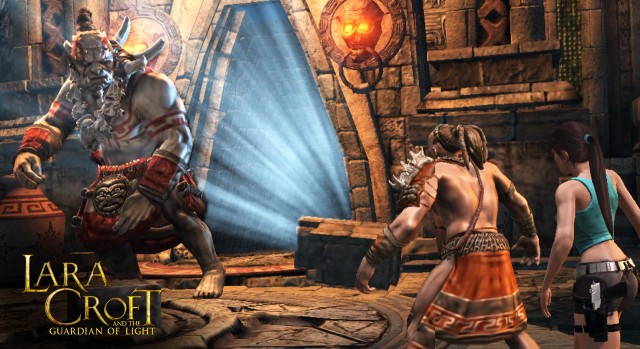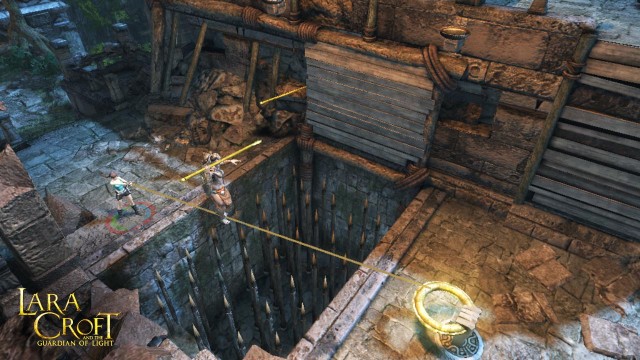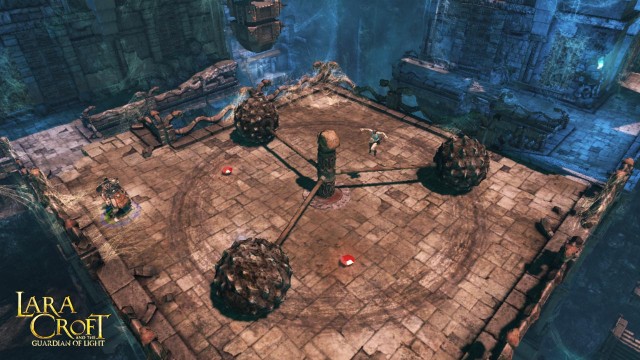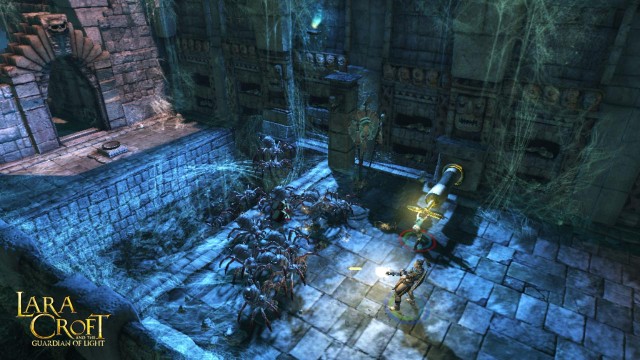
The Tomb Raider franchise is one of many inspired and borrowed ideas. Its combination of 3D platforming, combat and exploration were groundbreaking in its early years and created a worldwide phenomenon. In more recent times, the Tomb Raider games have been playing catch up to the very games it has inspired, such as Uncharted and Prince of Persia. With 2010’s Lara Croft and the Guardian of Light, a downloadable title with a subtle name change, this new take on Tomb Raider game aimed to differentiate itself from not only its contemporaries but its very own conventions. The result was a game that felt fresh yet familiar and was one of the best games of the year.
You may have heard this story before: the recovery of a lost artifact unleashes Xolotl, an ancient evil bent on escaping and destroying the world. Unsurprisingly, Lara dedicates herself to put the genie back in the bottle, but this time has the help of Totec, the (also newly-awakened) Guardian of Light and nemesis of Xolotl. Totec, however, is no mere helpful NPC; he is a fully playable character. This is where LCGoL starts to break away from the Tomb Raider mold as there is the option to play the campaign as either a single player adventure or as a completely co-operative multiplayer experience. I’ll touch on that as we go.
The dialogue and plot are pretty forgettable but that’s not what’s brought you to this dance, it’s EVERYTHING else.

Perhaps the most visually obvious differentiator for LCGoL is the new top-down 3D perspective view, immediately springing games like Diablo to mind. The stage design incorporates multiple levels of height and depth, usually connected by stairs or slopes. The layouts are typically simple but the level of detail makes everything very pretty, even though the camera is somewhat far away. The distance could have been an easy out, to not put as much effort in, but developer Crystal Dynamics go for it all here. Lara dashes around, moving from room to room (or perhaps tomb to tomb?) with nice animations. As usual, Lara is rather agile; she jumps and climbs almost anything, especially when using the spear in single player or assisted by Totec in co-op to get to out of reach places. Lara also has a grappling hook to climb up to ledges, rappel herself to lower spots on a cliff or to swing across holes or chasms. Totec is not as quite as agile as Lara, and he is heavier, so you have to work together and play to each other’s skills to get around. All this makes for fun exploration as each stage is littered with power ups, ammo, weapon upgrades and hidden collectables behind every nook and cranny.

Most of the collectables are linked to a persistent challenge system that rewards you with more upgrades and new weapons for finding hidden items, doing mini-challenges, and completing stages within the posted time. Defeating enemies and finding treasure contribute to a points system that also rewards you with more bonuses if you hit the gold, silver or bronze point targets. It’s darn near impossible to complete/find everything on a single play through so the replay value is definitely increased. All this collecting and being aware of scoring & points makes LCGoL feel arcadey rather than forcing itself to be immersive, and it’s actually refreshing and a hell of a lot of fun for the OCD set who needs to collect EVERYTHING.

Like Tomb Raider games of the past, the combat of LCGoL is centered on shooting. However, with the new top down view and sometimes frantic pace the game quickly delves into twin-stick shooter territory as the screen becomes populated with more and more enemies. It’s really enjoyable to have so many weapons at your disposal, each with a different feel, adding to the arcade atmosphere of the game. However, great combat aside, at its heart LCGoL is a puzzle game. Every stage you start or every tomb you enter is some sort of environmental puzzle. You’ll find lots of switches to pull and push, boulders to move onto buttons, always asking you to try to figure out how to either reach an item or get to the next exit. Each puzzle is almost always fresh, with not very much repetition.
In co-operative mode you must help each other, again playing off each other’s skills to get to switches and items. In single player Lara has some extra abilities and weapons (like the aforementioned spear) to help you figure things out on your own. There are some slight differences between single player and co-op puzzles to accommodate each mode but the end goals are usually the same. The puzzle elements of LCGoL are very satisfying and keep you coming back for more. With that in mind the game is probably more fun for two co-op partners who haven’t played the game before but then again two experienced people can whip through and try to beat the target completion times and get all the upgrades they missed.

Lara Croft and the Guardian of Light provides a much needed breath of fresh air into the Tomb Raider franchise. Just the simplest of modifications to a stale formula make it feel like a whole new experience; the top-down view, the twin stick gunplay and the addition of co-op were revelations by developer Crystal Dynamics. It really makes me wonder with great anticipation what they have in store as they reboot the 3D games with the simply-titled Tomb Raider. Whatever may come, LCGoL showed this reviewer that the franchise still has legs and can be something to be excited about again.
This review was based on a copy of the game purchased by the reviewer.


5 Comments